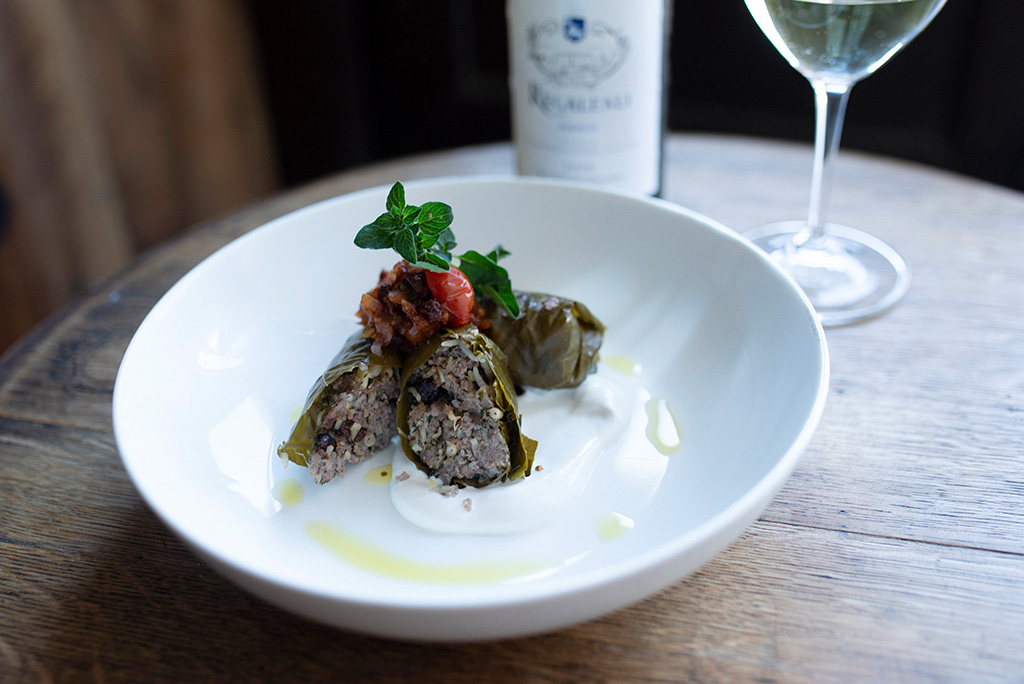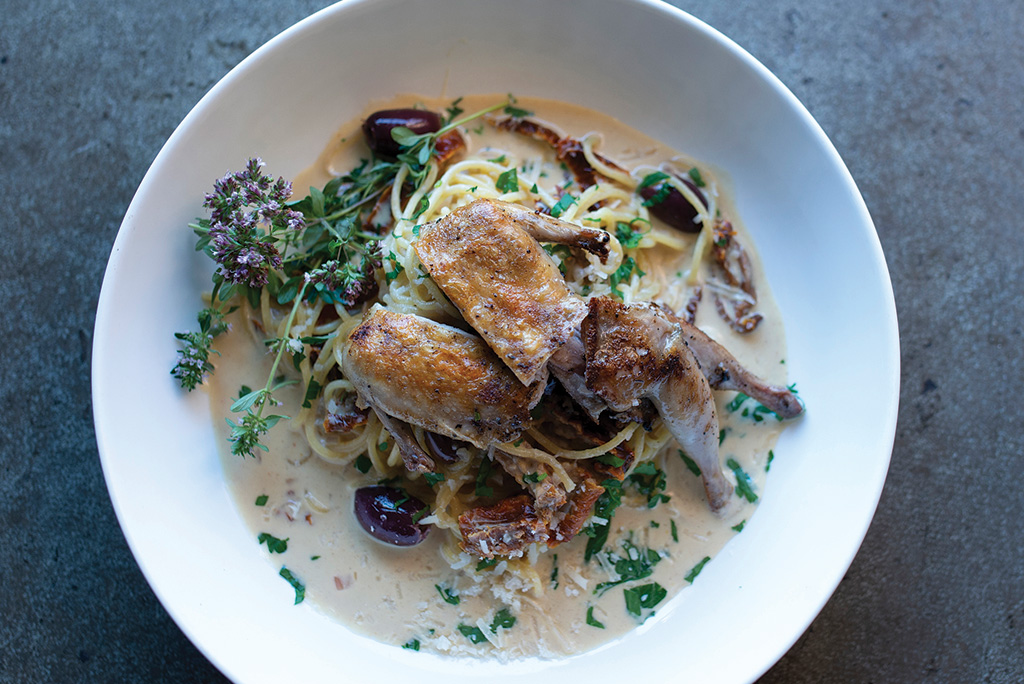With the advent of autumn, the days grow shorter, and the shadows grow longer across the mountains. The hunters in our community linger in the woods at the dawn and dusk to try their luck, and if victorious, their bounty will grace our tables.
Elk, deer, turkey, pheasant, quail, rabbit, duck—wild game is great for a variety of reasons. Hormone- and antibiotic-free and packed with protein, B vitamins and minerals (iron and zinc), game is considered leaner than farmed meats. According to a study by Purdue University, wild game has an ideal ratio of Omega-3 to Omega-6 fatty acids, making game one of the healthiest sources of good fat on earth. But most importantly, wild game is bursting with deep, rich flavor that ensures any meal featuring it won’t soon be forgotten.
And in our increasingly (and applaudingly) eco-conscious time, it’s worth noting that wild game is more environmentally friendly than its store-bought counterpart. Large-scale confined factory farming hurts the planet as much as it hurts humans and animals. Its offenses often include the proliferation of antibiotic-resistant bacteria, killing off aquatic eco-systems, and polluting soil, groundwater and air with heavy metals, phosphorus, nitrogen, pathogens, ammonia, hormones and methane. So, when choosing wild game, you dramatically reduce your carbon footprint.
But how to prepare it? Here, Scott Mason, head of the fabled “Mason Mafia” of local restauranteurs and chefs, has been serving up mouth-watering meals at Enoteca and the Ketchum Grill for 30 years and continues to receive rave reviews from locals and visitors alike. “The Grill” was selected as one of the “eight best Ski town restaurants” by Snow Country Magazine with “food rivaling Manhattan’s best,” representing what is best in “American Cuisine”—local and seasonal venison, lamb, poultry and fish, with many of the recipes (including the three featured here) dating back to the early days of the Masons’ tenure, recipes that have been refined over time.
Pheasant Dolmas

“This is a fun Greek and Turkish classic, normally made with lamb. The pheasant legs make a nice light dolma,” says Mason.
3 pounds boned and ground
pheasant legs
1 tsp garlic, chopped
2 yellow onions, diced
1 bunch fresh mint, chopped
½ cup currants
½ cup diced tomatoes
½ cup pine nuts
3 tbsp olive oil
1½ cups raw, white rice
3 tsp kosher salt
1 tsp fresh ground pepper
30 grape leaves
3 cups white wine
½ cup lemon juice
Sauté onion and garlic in 3 tablespoons olive oil over medium heat for about 5 minutes until soft. Set aside to cool. In a bowl, mix the ground pheasant with the raw rice, currants, pine nuts, tomatoes and spices. Stir in the cooled onion and garlic. With a tablespoon, shape the pheasant mixture into golf ball-sized ovals and wrap each oval into a grape leaf. Place grape leaf dumpling/dolmas into a deep pan with a tight-fitting lid. Cover with inexpensive white wine and lemon juice and cook covered in a 350˚F oven for 45 minutes. Serve with a light lemon cream sauce or tomato-mint relish.
Suggested wine pairing: Vietti Arneis or Vietti Perbacco Nebbiolo
Elk Saltimbocca

“Normally made with veal, this variation with elk is a favorite among everyone who eats it and lives up to its name ‘little bites that jump in your mouth,’” says Mason.
2 pounds trimmed elk leg
16 slices of prosciutto
16 sage leaves
1 pinch kosher salt
1 pinch fresh ground pepper
2 shallots, diced
½ cup Madeira wine
¼ pound unsalted butter
½ lemon, juiced
Slice elk across grain into 2-ounce pieces. Pound lightly to the correct shape and thickness. Season with salt and pepper and place one sage leaf on top. Now wrap each piece in a slice of prosciutto and place seam down. Elk may be cooked over a hot coal grill or in a hot sauté pan with olive oil.
For the pan: After cooking, remove elk pieces to plate and add shallots to the pan. Sauté shallots briefly and add Madeira wine to deglaze pan. Add lemon and finish with unsalted butter. Serve hot with creamy polenta.
Suggested wine pairing: Dunham Syrah or Fonterutoli Chianti
Quail Pasta

“Thirty years ago, we used grilled chicken livers as the protein on this mustardy pasta. The grilled quail elevates the dish from rustic to refined,” says Mason.
For the pasta
1/3 cup Dijon mustard
1 tsp minced garlic
1/4 cup sun dried tomatoes
(softened in warm water)
12 Kalamata olives
1 tbsp chopped fresh rosemary
1 tbsp chopped fresh thyme
2 tbsp chopped fresh parsley
2 cups chicken stock
(preferably homemade or low salt)
1/4 cup heavy cream (optional)
6 portions fresh linguine
1/2 cup freshly grated Parmesan cheese
Place all ingredients, except the cooked pasta, in a sauté pan large enough to hold the 6 servings of cooked pasta, bring to a boil, add cooked pasta, and toss together. Heat sauce and pasta until boiling and desired consistency is reached. If the pasta seems a little too dry, just add a touch more stock. If the sauce seems a little too thin, just cook off some of the liquid. With tongs, remove pasta from sauce and divide between 6 serving plates or into one large serving bowl. Pour remaining sauce over the top. Serve hot pasta with the quail arranged on top and freshly grated Parmesan cheese. If you want a lower fat pasta, just leave out the cream. Mason serves the sauce on the thinner side at the Ketchum Grill.
Suggested wine pairing: Melville Pinot Noir or Talley Rosemary’s Pinot Noir

Mason who has been serving up memorable meals at Enoteca and the Ketchum Grill for 30 years. At his restaurants, Mason cures and dries his own meats and makes almost everything from pizza dough to desserts. He says, “We do buy cheeses and try to support regional purveyors as much as possible.”


